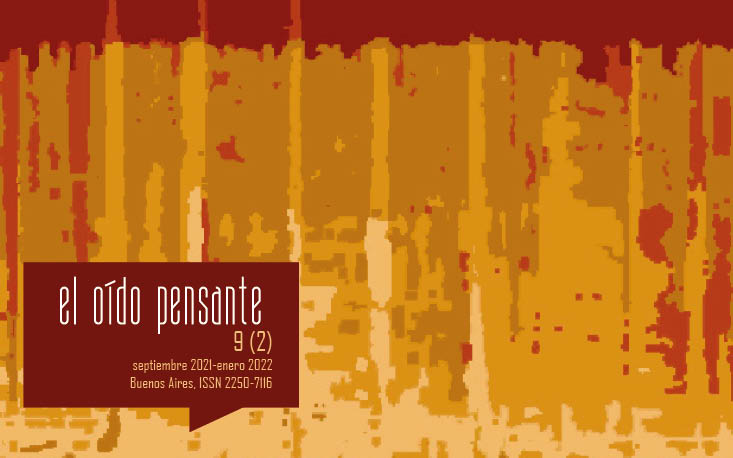Dance in the DJ’s Music. Second Person Interactions in Electronic Dance Music Parties
Abstract
Electronic music parties are musical performances where a DJ plays music for a dancing crowd. This interaction is considered very relevant for the musical practice in several studies, but their particular features have not yet been studied in depth. In this paper we address the DJ's perspective based on the microanalysis of three interviews conducted by the authors. The results were interpreted from the Second Person’s Perspective, which proposes the direct perception of psychological states in body expression. It was concluded that DJ-audience interactions have features of second person's perspective: DJs attribute being up or down to the audience (as a whole) based on gestalt perception of dance movements’ intensity, which is assumed to be a consequence of music energy level. The musical set that the DJ mixes during the party is defined by these attributions and oriented to keep the audience up. The relevance of the audience's body interaction with music puts the dance in the center of DJ’s musical practice, producing a genuine second person interaction in this particular social context.Downloads
References
Auslander, P. (2008). Liveness: Performance in a Mediatized Culture, 2nd edition. London: Routledge.
Blázquez, G. (2012). “I Love the Nightlife”: músicas, imágenes y mundos culturales juveniles en Argentina. Trans. Revista Transcultural de Música, 16( 2), 1-26. Recuperado de http://www.sibetrans.com/trans/articulo/406/i-i-love-the-nightlife-i-mu-sicas-ima-genes-y-mundos-culturales-juveniles-en-argentina
Blánquez, J. (2018). Loops 2. Una historia de la música electrónica en el siglo XXI. Barcelona: Reservoir Books.
Blánquez, J. y O. León (Eds.) (2018). Loops 1. Una historia de la música electrónica en el siglo XX. Barcelona: Reservoir Books.
Broughton F. y Brewster B. (2002). How to DJ (Properly). The Art and Science of Playing Records. London: Bantam.
Burger, B., Thompson, M., Luck, G., Saarikallio, S. y Toiviainen, P. (2010). Influence of Musical Features on Characteristics of Music-Induced Movements. Proceedings of ICMPC11. Seattle, USA.
Burger, B. y Toiviainen, P. (2020). Embodiment in Electronic Dance Music: Effects of Musical Content and Structure on Body Movement. Musicae Scientiae, 24(2). doi: https://doi.org/10.1177/1029864918792594
Burland, K. y Pitts, S. (2014). Coughing and Clapping: Investigating Audience Experience. Farnham: Asghate.
Colombetti, G. y Thompson, E. (2008). The Feeling Body: Towards an Enactive Approach to Emotion. En: W. Overton, U. Müller y J. Newman (Eds.), Developmental Perspectives on Embodiment and Consciousness (pp. 45-68). Nueva York: Lawrence Erlbaum Associates.
Corbin, J. y Strauss, A. (1996). Basics of Qualitative Research. Techniques and Procedures for Developing Grounded Theory. (4th Edition). Sage: California.
Gallo, G. M. (2016). Libertades coreografiadas: palabras habladas, comunicaciones corporales y códigos en pistas dance de la ciudad de Buenos Aires. Estudios sociológicos, 34(100), 41-64. doi: 10.24201/ES.2016V34N100.1387
Geeves, A. M., McIlwain, D. J. y Sutton, J. (2016). Seeing Yellow: ‘Connection’ and Routine in Professional Musicians’ Experience of Music Performance. Psychology of Music, 44(2), 183-201. doi: https://doi.org/10.1177/0305735614560841
Glaser, B. y Strauss, A. (1967). The Discovery of Grounded Theory. New Jersey: Aldine Transaction.
Gomila, A. (2002). La perspectiva de la segunda persona de la atribución mental. Azafea, 4, 123-138. doi: https://doi.org/10.14201/3719
Gomila, A. y Pérez, D. (2017). Lo que la segunda persona no es. En D. Pérez y D. Lawler (Comps.), La segunda persona y las emociones (pp. 275-297). Buenos Aires: SADAF.
Gomila, A. y Pérez, D. (2018). Mental Attribution in Interaction: How the Second Person Perspective Dissolves the Problem of Other Minds. Daimon, 75, 75-86. doi: https://doi.org/10.6018/daimon/332611
Laban, R. (1950). El dominio del movimiento. Móstoles: Editorial Fundamentos.
Lakoff, G. y Johnson, M. (1980). Metaphors We Live by. Londres: The University of Chicago Press.
Lakoff, G. y Johnson, M. (1999). Philosophy in the Flesh. Nueva York: Basic Books.
Leman, M. (2016). The Expressive Moment. Massachusetts: The MIT Press.
Marchiano, M. y Martínez, I. C. (2018). Expressive alignment with timbre: changes of sound-kinetic patterns during the break routine of an electronic dance music set. En R. Parncutt y S. Sattmann (Eds.), Proceedings of ICMPC15/ESCOM10. Graz: Universidad de Graz.
Martínez, I. C. (2018). Hacer sentido con el cuerpo en la música. Revista Argentina de Musicología, 19, 43-58. Recuperado de http://ojs.aamusicologia.org.ar/index.php/ram/article/view/264
Martínez, I. C., Español, S. y Pérez, D. (2018). The Interactive Origin and the Aesthetic Modelling of Image-Schemas and Primary Metaphors. Integrative Psychological and Behavioral Science, 52(4), 646-671. doi: https://doi.org/10.1007/s12124-018-9432-z
Meyer-Dinkgräfe, D. (2015). Liveness: Phelan, Auslander, and After. Journal of Dramatic Theory and Criticism, 29(2), 69-79. doi: https://doi.org/10.1353/dtc.2015.0011
Pérez, D. (2013). Sentir, desear, creer. Una aproximación filosófica a los conceptos psicológicos. Prometeo: Buenos Aires.
Pérez, D. y Gomila, A. (2018). La atribución mental y la segunda persona. En T. Balmaceda y K. Pedace (Comps.), Temas de filosofía de la mente (pp. 69-98). SADAF: Buenos Aires.
Pérez, D. y Gomila, A. (2021). Social Cognition and the Second Person in Human Interaction. London: Routledge.
Reynolds, S. (2018). Prólogo. En J. Blánquez y O. León (Eds.), Loops 1. Una historia de la música electrónica en el siglo XX. Barcelona: Reservoir Books.
Schweikard, D. P. y Schmid, H. B. (2013). Collective Intentionality. En E. N. Zalta (ed.) The Stanford Encyclopedia of Philosophy. Recuperado de https://plato.stanford.edu/archives/sum2013/entries/collective-intentionality
Solberg, R. T. y Dibben, N. (2019). Peak Experiences with Electronic Dance Music. Music Perception, 36(4), 371-389. doi: https://doi.org/10.1525/mp.2019.36.4.371
Solberg, R. T. y Jensenius, A. (2019). Group Behaviour and Interpersonal Synchronization to Electronic Dance Music. Musicae Scientiae, 23(1), 111-134. doi: https://doi.org/10.1177/1029864917712345
Stern, D. N. (2010). Forms of Vitality: Exploring Dynamic Experience in Psychology and the Arts. New York: Oxford University Press.
Tanco, M. (2018a). Acerca de lo Narrado en la Performance: Un estudio de la experiencia musical del performer a través de la analogía del Narrador. (tesis de doctorado). Universidad Nacional de La Plata, La Plata, Argentina. Recuperado de http://hdl.handle.net/10915/67834
Tanco, M. G. (2018b). La comunicación performer-público en la performance de la música académica. Revista de Psicología, 17(2), 22-44. doi: https://doi.org/10.24215/2422572Xe020
Toiviainen, P, Luck, G. y Thompson, M. (2010). Embodied Meter: Hierarchical Eigenmodes in Music-Induced Movement. Music Perception, 28(1), 59-70. doi: https://doi.org/10.1525/mp.2010.28.1.59
Turino, T. (2008). Music as Social Life: The Politics of Participation. Chicago: University of Chicago Press
Vasilachis, I. (2006). Estrategias de investigación cualitativa. Gedisa: Spain.























